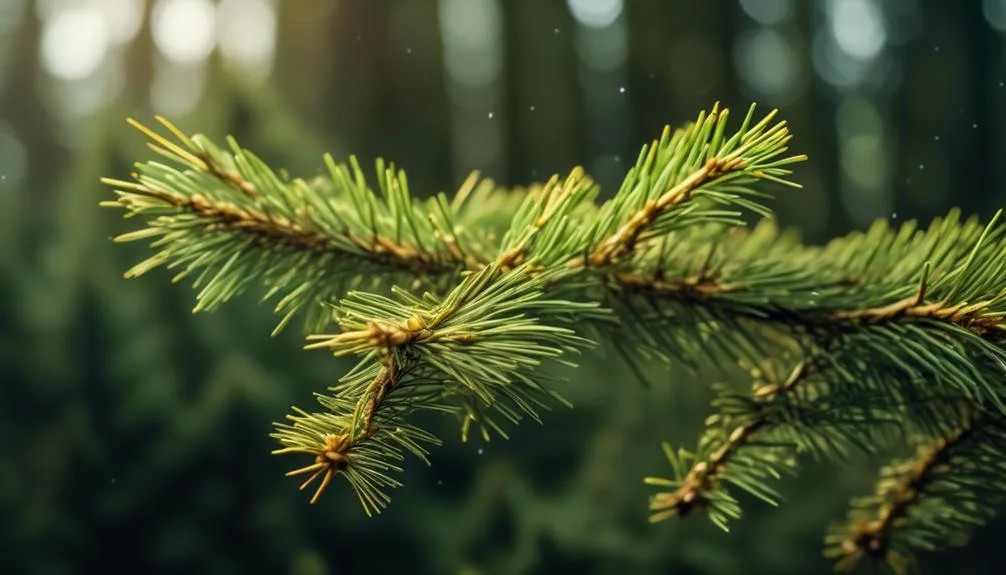Have you ever wondered why spruce tree foliage turns yellow? The sight of once lush green needles fading to a pale, yellow color can be disheartening.
This transformation can be caused by various factors, including environmental stress and nutrient deficiencies. The reasons behind this change are both diverse and intriguing.
Stay tuned to learn more about the surprising causes of this natural wonder losing its luster.
Normal Needle Shedding
As the seasons change, spruce trees naturally shed their older needles to make room for new growth, a process that's essential for their health and vitality. This shedding is a normal part of the spruce tree's life cycle, and it's important to understand that as needles age, they naturally discolor and eventually fall off.
You may notice that the older needles towards the inner part of the tree turn yellow or brown before dropping. This is a sign that the tree is making way for fresh, healthy growth. It's a natural process that helps the tree conserve energy and resources, ensuring that it can thrive and remain vibrant.
Environmental Stressors
If you've noticed your spruce tree's needles turning yellow or brown and falling off, it could be a sign of environmental stressors affecting its health and vitality.
Climate change impact is a significant factor contributing to the stress experienced by spruce trees. Changes in temperature and precipitation patterns can lead to increased susceptibility to pests and diseases, as well as water stress.
Additionally, air pollution effects can directly impact the health of spruce trees. Pollutants such as ozone and sulfur dioxide can damage the needles and hinder the tree's ability to photosynthesize effectively.
These environmental stressors weaken the tree's defenses, making it more vulnerable to other stress factors.
Monitoring and mitigating these stressors are crucial for maintaining the health and resilience of spruce trees in the face of environmental challenges.
Nutrient Deficiencies
Are your spruce trees receiving all the essential nutrients they need to thrive and remain healthy? Leaf discoloration can often be a sign of nutrient deficiencies in spruce trees.
Adequate plant nutrition is crucial for vibrant, healthy foliage. Yellowing needles, stunted growth, or sparse foliage are common indicators of nutrient deficiencies. Nitrogen deficiency can cause older needles to turn yellow, while younger needles may appear stunted. On the other hand, a lack of iron can lead to yellowing of new growth.
It's essential to address nutrient deficiencies promptly to ensure the overall health and vitality of your spruce trees. Conducting a soil test can help identify specific deficiencies and allow for targeted supplementation to provide your trees with the necessary nutrients for optimal growth and lush, green foliage.
Pests and Diseases
Pests and diseases pose significant threats to the health and vitality of your spruce trees, potentially causing damage to the foliage and overall well-being of the trees. Here are some important things to know about dealing with pests and diseases:
- Fungal infections: Keep an eye out for signs of fungal infections such as discolored or wilting foliage. Fungal infections can spread rapidly and cause serious harm to your spruce trees.
- Insect infestations: Insects like spruce spider mites and adelgids can wreak havoc on spruce trees. Look for tiny webs or stippling on the needles as indicators of infestations.
- Treatment options: Effective treatments for fungal infections and insect infestations include fungicides and insecticides. It's crucial to act promptly to prevent further damage.
- Prevention methods: Regularly inspect your trees for signs of pests and diseases, and consider implementing preventive measures such as proper watering, pruning, and maintaining good air circulation around the trees.
Soil Ph Imbalance
Your spruce tree's yellowing foliage may be a sign of a soil pH imbalance, impacting its overall health and growth. Soil pH refers to the level of acidity or alkalinity in the soil. Spruce trees thrive in slightly acidic soil with a pH range of 4.5 to 6.5.
If the soil becomes too acidic, nutrients like calcium and magnesium may become less available to the tree, causing the foliage to turn yellow. On the other hand, if the soil becomes too alkaline, essential nutrients such as iron and manganese may become inaccessible, leading to the same yellowing effect.
Testing the soil pH can help determine if it's too acidic or alkaline. Depending on the results, adding amendments such as sulfur for alkaline soil or lime for acidic soil can help restore the balance and improve the overall health of your spruce tree.
Conclusion
In caring for your spruce tree, monitoring for nutrient deficiencies, pests, diseases, and soil pH is essential.
By addressing environmental stressors and providing proper care, your spruce tree can regain its lush, green foliage.
With attentive nurturing, you can ensure the long-term beauty and health of your tree.

My interest in trees started when I first saw the giant sequoias in Yosemite.
I was a teenager then, and I remember thinking, “I need to learn more about this.”
That moment stuck with me.
A few years later, I went on to study forestry at Michigan Tech.
Since graduating, I’ve worked in a mix of hands-on tree care and community education.
I’ve spent over ten years helping people understand how to plant, maintain, and protect the trees in their neighborhoods.
I don’t see trees as just part of the landscape.
They are living things that make a real difference in our daily lives.
